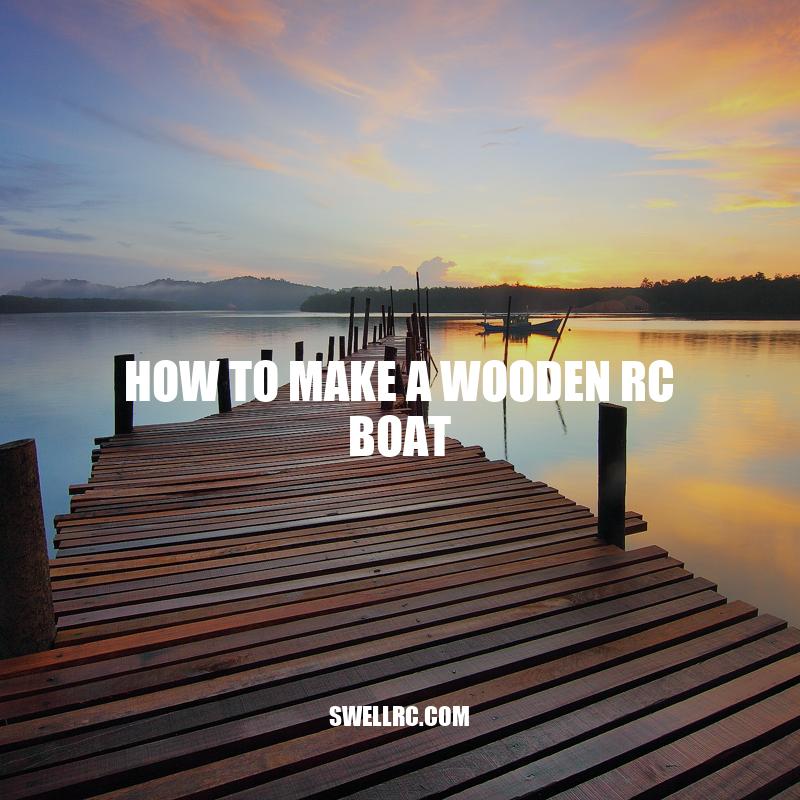How to Build a Wooden RC Boat: DIY Guide
When it comes to remote control (RC) boats, the market is filled with many options. Although buying a ready-made RC boat may be convenient, building your own wooden RC boat could not only give you a sense of pride in your creation, but it can also be a rewarding and enjoyable hands-on experience. To build a wooden RC boat, you just need access to some basic tools and materials, and some patience and persistence. While the process may seem daunting, it’s important to know that it’s achievable even for those with no prior experience in woodworking or model making. Building your own RC boat can be a great way to spend your time, challenge your mind, and have fun. In this article, we’ll provide a step-by-step guide on how to make a wooden RC boat, from choosing the right materials to putting the finishing touches on the project.
Materials Needed
To make a wooden RC boat, you’ll need some basic materials, including:
- Marine plywood (either 3mm, 4mm or 6mm thickness)
- Epoxy resin, hardener, and applicator
- Stainless steel screws or brass screws
- Paint or varnish
- RC motor, propeller, speed controller, servo, battery pack, and transmitter
- Sandpaper (coarse and fine grit)
- Toothpicks or wooden dowels
- Masking tape or painter’s tape
- Wood glue
- A saw (can be a handsaw or a jigsaw)
- A drill
- A ruler or tape measure
- A pencil
These materials can be found at local hardware stores or online through websites such as Amazon or Home Depot. Make sure to choose marine-grade plywood, which is specifically designed for use in wet environments and will stand up to water splashes and humidity better than regular plywood. Additionally, read and follow the instructions on any products you purchase for your project to ensure success.
Building the Hull
The hull of the boat is the most important part of the build, as it provides the structure and buoyancy needed for the boat to float and maneuver properly. Here is a step-by-step guide to building a wooden RC boat hull:
| Step | Instructions |
|---|---|
| Step 1 | Draw the shape of the hull onto the marine plywood and cut it out using a saw. |
| Step 2 | Cut notches into the plywood along the edges, then glue and clamp the pieces together using wood glue. |
| Step 3 | Sand the hull to remove any rough edges or bumps, using coarser grit sandpaper first and then finishing with a finer grit. |
| Step 4 | Apply epoxy resin to create a waterproof seal on the wood, inside and out. |
| Step 5 | Install any additional features to the hull, such as a keel or skeg to improve stability. |
It’s important to keep in mind that the shape and size of the hull will affect the speed and stability of the boat. A lighter and narrower hull will go faster but may be less stable, while a wider and heavier hull will be more stable but less fast. Additionally, the placement of the motor and the weight distribution of the boat will also affect its performance. Experimenting with different designs and configurations can be a fun part of the process.
How to Build a Boat out of Wood?
Building a boat out of wood can be a rewarding and enjoyable experience. Here are some basic steps to follow:
- Choose the type and size of the boat you want to build
- Select the type of wood you want to use (cedar, mahogany, plywood, etc.)
- Get the necessary tools and materials (hammer, saw, nails, screws, etc.)
- Prepare the wood and cut it to the appropriate size and shape
- Assemble the boat according to the design plan
- Seal and protect the wood with varnish or other waterproofing agents
- Add finishing touches like seats, oars, and a mast
If you are new to boat building, it’s recommended to start with a simple design and consult guides online or books like “Wooden Boat Building” by Howard Irving Chapelle. Websites like woodenboat.com and boatsafe.com offer valuable resources on boat building techniques and safety tips.
There are also boat building kits available online, such as those from Chesapeake Light Craft, that provide all the materials and instructions to build a wooden boat.
Installing the Motor
Once the hull is complete, it’s time to add the motor which will power your wooden RC boat. Follow these steps to install the motor:
- Choose a motor that is appropriate for the size of your boat. The motor should be powerful enough to move the boat without being too heavy.
- Drill a hole in the hull where the motor will be mounted. This hole should be the same diameter as the motor shaft.
- Mount the motor in the hole using screws and a bracket (if necessary).
- Attach the propeller to the motor shaft, making sure it is securely fastened.
- Connect the motor to the speed controller, then plug the speed controller into the battery.
- Test the motor to make sure it is working properly before installing the rest of the electronics and wiring.
One popular motor for RC boats is the Brushless Motor which provides high power with low maintenance needs. Another important consideration when choosing a motor is determining the voltage needed for your particular boat. Make sure to consult the manufacturer’s instructions or consult with a motor expert if you’re unsure. Happy sailing!
How to choose a brushless motor for RC boat?
When it comes to choosing a brushless motor for your RC boat, it can be a little overwhelming. Here are some things to consider:
- Size of the boat – Make sure to get a motor that is suitable for the size and weight of your boat.
- RPM range – Look for a motor that has a wide RPM range, allowing you to make adjustments based on your specific needs.
- KV rating – This indicates the RPM per volt, so a lower KV rating will give you more torque while a higher rating will give you more speed.
- Build quality – Look for motors with high-quality bearings and magnets that will last longer and perform better.
There are many websites and products available for brushless motors, so do your research and read reviews to find the best option for your RC boat.
Wiring and Electronics
Wiring and electronics are an essential aspect of creating a functional RC boat. Here are some steps to follow when setting up the wiring and electronics:
- Begin by attaching the receiver to the boat’s interior using adhesive or screws.
- Connect the receiver to the speed controller using the appropriate cables.
- Attach any necessary servos and linkages to the receiver, ensuring that they are properly calibrated.
- Connect the battery to the speed controller, double-checking that the polarity is correct.
- Once everything is connected, test the electronics to make sure they are communicating properly.
It’s important to be cautious when it comes to safety while setting up the wiring and electronics. Always ensure that the battery is disconnected when handling wires and be careful not to create any short circuits. One product that can help with wiring and organization is a Cable Tie Assortment Kit, which includes a variety of cable ties in different sizes for all types of cables. Additionally, there are many resources available online that can help with electronic setup and troubleshooting, such as RC boat forums and online communities.
How to design a RC boat?
Designing an RC boat can be a fun and exciting project, especially if you love boating and tinkering with electronic gadgets. Here are some steps to help you create your own custom RC boat:
- Research and gather inspiration for design ideas
- Create a blueprint or design plan
- Choose the materials you will use to construct your boat
- Assemble the boat’s main structure and hull
- Add the necessary components such as motor, battery, and radio control system
- Test and refine your boat until it performs the way you want it to
If you’re looking for more detailed guidance or product recommendations for building your own RC boat, check out websites like RCGroups.com or RCBoatMag.com. There are also kits and pre-made boat parts available for purchase from online retailers such as HobbyKing.com and TowerHobbies.com.
Final Touches
Once the wiring and electronics are set up, it’s time to add some finishing touches to the boat to make it stand out. Here are some tips:
- Paint the boat with a waterproof coating to help protect it from water damage.
- Add decals or stickers to customize the boat’s appearance.
- Add rope or netting accents for a nautical touch.
- Install LED lights for a cool nighttime effect.
To waterproof the boat, try using a marine-grade varnish or sealer. This will help provide a durable and waterproof finish. Another option is waterproof vinyl wrap or adhesive vinyl graphics for a more custom look. One product that can help with lighting effects is the Remote Controlled LED Strip Lights which can be easily installed underwater and offers a wide range of color and flashing options.
There are also many online resources for RC boating enthusiasts looking to take their boats to the next level, such as online forums or social media groups. These communities can provide valuable advice and support for everything from troubleshooting to customization ideas.
How do you put new decals on a boat?
To put new decals on a boat, follow these simple steps:
- Clean the surface thoroughly with soap and water to remove any dirt or residue. Dry the area with a clean towel.
- Apply a solution of water and rubbing alcohol to the surface to remove any remaining residue or contaminants. Allow the area to dry completely.
- Peel the backing off the decal, being careful not to touch the adhesive surface with your fingers.
- Align the decal with the desired location on the boat and apply it one section at a time, starting from the centre and working your way outward.
- Smooth out any bubbles or wrinkles using a squeegee or credit card.
- Allow the decal to dry completely before exposing it to water or other elements.
If you need new boat decals, you can find a variety of designs and styles online through websites such as boatdecals.biz, boatus.com, or decalcomania.com.
Conclusion
Making a wooden RC boat is a fun and rewarding DIY project that can also provide hours of entertainment on the water. While it may seem complex, breaking the process down into manageable steps will make it easier to follow along. Start by acquiring the necessary materials and tools, building the hull, installing the motor and electronics, and then finishing the boat to your liking. Adding personal touches such as unique paint jobs, graphics or even an LED lighting system can also make your boat stand out from the crowd.
With the right planning and execution, anyone can build a wooden RC boat that looks and performs like a professional-grade model. Just remember to take your time with each step, follow safety precautions, and seek out advice from professionals or fellow DIY enthusiasts if needed. So, get ready to launch your own homemade wooden RC boat and watch it glide across the water – it’s an impressive sight to behold!



